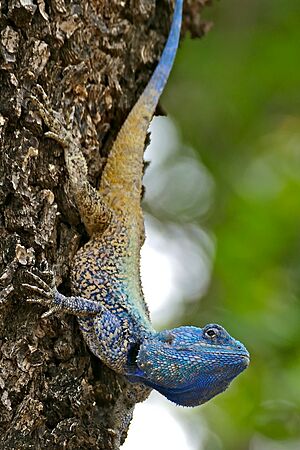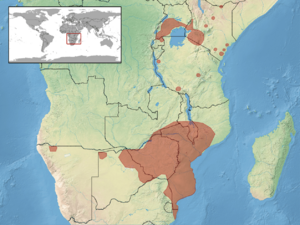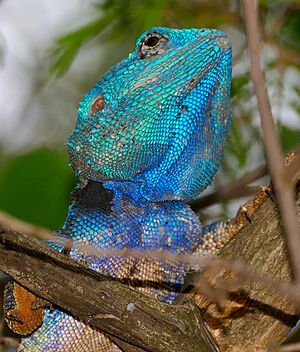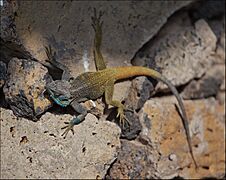Black-necked agama facts for kids
Quick facts for kids Black-necked agama |
|
|---|---|
 |
|
| Male in the Kruger National Park, South Africa |
|
| Conservation status | |
| Scientific classification | |
| Genus: |
Acanthocercus
|
| Species: |
atricollis
|
 |
|
| Synonyms | |
|
|
The black-necked agama (also known as the southern tree agama) is a type of lizard. Its scientific name is Acanthocercus atricollis. You can find these interesting lizards in many parts of Africa, especially in the east, central, and southern areas. They are very common in places like the Kruger National Park in South Africa.
Contents
About the Black-necked Agama
Male and female black-necked agamas are about the same size. They have similar tail lengths too. However, adult males have slightly bigger heads than females. This helps them when they compete with other males for their living space.
Female agamas are ready to have babies when they are about 9.6 centimeters long. Males are ready when they are about 8.2 centimeters long.
Daily Life and Habits
Black-necked agamas live in groups, almost like a family. Each group has a main male, several females, and some young lizards. The main male protects their area from other males. They often fight to defend their space.
These lizards are usually active during the day. But sometimes, you might see them moving around at night too. They can easily live near people's homes.
Agamas are "ambush hunters." This means they wait quietly for their food to come to them. They spend only about 4% of their time moving around. When they are still, they often sit on tree branches (42% of the time) or on tree trunks (35%). Sometimes, they are on the ground (23%).
You might find more black-necked agamas living near villages. This is because there are fewer natural enemies, like snakes or birds of prey, in these areas. Also, they prefer thicker trees with more leaves, which are often found near human settlements.
What Do They Eat?
Black-necked agamas mainly eat insects. Their favorite foods include grasshoppers, beetles, and ants. They eat many different kinds of bugs, about 10 different types of arthropods. They also eat millipedes, which many other lizards avoid.
When scientists look at what's inside their stomachs, they find lots of ants (92% of the items). They also find some beetles (4%). By how much space the food takes up, grasshoppers make up a large part of their diet (27%). Beetles are next (26%), followed by ants (18%). Young agamas mostly eat ants, but they also enjoy beetles and grasshoppers. The types and amounts of food they eat can change depending on the season.
How They Reproduce
Black-necked agamas have a specific time of year for having babies. In the southern parts of Africa, males are ready to mate from August to September. Females are ready from August to December.
Females lay one group of eggs each year. On average, they lay about 11 eggs. Larger females usually lay more eggs than smaller ones.
Where They Live
You can find the black-necked agama in many countries across Africa. These include Eritrea, Somalia, Ethiopia, Sudan, South Sudan, Uganda, D.R.C., Kenya, Tanzania, Zambia, Malawi, Mozambique, Zimbabwe, Angola, Botswana, Namibia, South Africa, and Eswatini.
Different Types of Black-necked Agamas
Scientists usually recognize two main types, or "races," of the black-necked agama. Four other types have been described, but they are not very different from each other.
- A. a. atricollis (Smith, 1849) – This is the southern tree agama, found in southern Africa.
- A. a. loveridgei (Klausewitz, 1957) – This type is found in Tanzania.
Gallery






